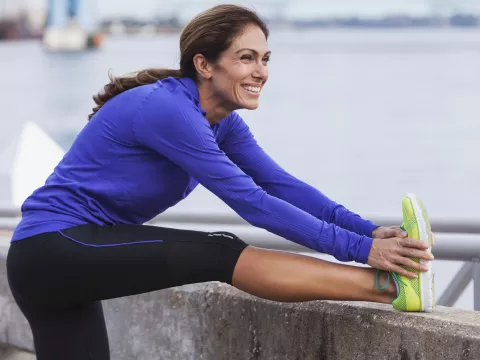- AdventHealth Foundation Central Florida

Whether you’re new to running or already have a marathon under your belt, you’ll have to do some training to get ready for your next 5K. Refresh your memory on three training basics in preparation for your upcoming run.
Whatever your pace, these three pointers can help you train for your next race safely.
1. Focus on Full-Body Conditioning
To carry you over the finish line, your body will likely need some conditioning before your race. Running is a high-impact exercise that involves many muscle groups, joints, tendons and ligaments. It's a good idea to get a conditioning plan from a physical therapist to ensure your body can run the race and finish strong.
Typically, runners spend a lot of energy on mileage and forget about strength training. Do some exercises that force movement in several planes of motion to strengthen your frontal plane muscles, like the hip abductor and rotator muscles. Your deep hip muscles must be able to stabilize your leg bones while running.
Don’t forget your core and upper body strength, either. During a run, your upper back and shoulder girdle sustain your head and shoulders, and your arms are constantly swinging alongside you. Running impacts your entire body, so your training should, too.
2. Know When to Keep or Replace Your Running Shoes
Your perfect shoe can be difficult to pinpoint. If you have high arches or are prone to conditions like plantar fasciitis, you’ll need shoes that accommodate your feet fully. The right running shoe will help support and balance your body to prevent injuries.
Already have a pair of shoes you rely on? Check the tread on your shoes to decide if they need to be replaced. If you see too much wear in one area, it might indicate that you are putting too much force in that area. In that case, you might need new running shoes to balance your body during your run.
If you run regularly, your shoes will probably last for three to four months, on average. Your tread will also be affected by the surface on which you're running. For example, running outdoor trails requires a different shoe tread than running track or on pavement.
3. Prevent Injuries by Training With a Physical Therapist
Runners often get physical therapy when they have knee pain, which is frequently caused by iliotibial (IT) band syndrome. Your IT band runs over your femur (thigh bone) and attaches to a muscle at the top of your hip, which needs to be flexible and strong in different planes of motion. If that muscle is weak, you might start to feel pain.
A physical therapist can determine if this muscle or others in your body are weak and could make you susceptible to different injuries. Their assessments can test your range of motion, strength, dynamic function and common movement patterns to correct imbalances.
After about one or two months of consistent training exercises, your muscles will start to adapt, and you’ll likely feel a difference in your running performance.
Running can be a truly fulfilling activity for mind, body and spirit. Just be sure to get off on the right foot with proper training, shoes and your utmost safety in mind. Training your body beforehand is essential to running a 5K — and finishing strong.



